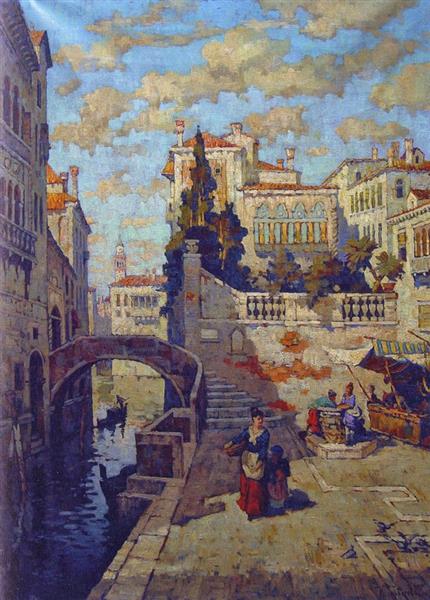Description
The work "Venice 1919", by Konstantin Gorbatov, is a magnificent example of the artist's domain on light and color, as well as its ability to capture the essence of a place in a single moment. When observing this painting, one can easily imagine lost in the serenity of the Venetian channels, surrounded by the iconic structures that make this unique city in the world.
The composition of the painting is carefully balanced. Gorbatov uses the perspective of the channels to guide the viewer's gaze towards the bottom, where a series of traditional Venetian buildings rise majestically. The choice of point of view is particularly effective; It places us at water height, allowing the observer to feel like a gondolero sailing gently on the channel. This approach also highlights the verticality of buildings, which seem to emerge directly from the water, a characteristic feature of Venice.
The use of color in this work is worth mentioning. Gorbatov uses a palette of soft tones that evoke a feeling of calm and tranquility. The pastel colors of the facades of the buildings are reflected in the calm waters of the channel, creating a visual harmony that highlights the purity and cleaning of the light. This luminosity is a testimony of Gorbatov's talent to capture the diaphanous atmosphere of Venice, where sunlight filters between buildings and reflected in water. The flashes of blue in the sky and the water, together with the warm terracotta and ocher tones of the constructions, are combined to form a chromatic symphony that delights the view.
Unlike other urban landscapes, this scene lacks human figures, which can be interpreted as an intention of the artist to emphasize loneliness and peace inherent to the environment. The absence of human life allows the spectator to concentrate completely on architecture and in the reflex game, almost as if Venice existed only to be contemplated in its magnificence, without the interference of the daily bustle.
Konstantin Gorbatov, a Russian painter born in 1876, moved to Germany in the years before the Russian revolution and subsequently traveled extensively in Europe. His love for Italy and, in particular, for Venice, is palpable in his works. This painting, Dady in 1919, it reflects a period in which Gorbatov had already developed a mature style, characterized by its ability to imbue its landscapes with a specific sense and time. It is distinguished by its ability to capture not only the visual image, but also the emotional atmosphere of the places it painted.
Compared to other artists who have portrayed Venice, such as Canaletto or Turner, Gorbatov's work is less great but more intimate. While Caretto focused on the detailed panoramic and architectural views and Turner in dramatic atmospheric effects, Gorbatov seems to look for a more personal and serene connection with the city. Its technique of loose brushstrokes and diluted colors suggests an impressionist influence, although filtered through its own emotional prism.
In conclusion, "Venice 1919" by Konstantin Gorbatov is not only a pictorial representation of an emblematic place, but a visual experience that transports the viewer to the essence of Venice itself. It is a testimony of the artist's talent and his deep connection with the places he chose to immortalize in his work. The painting invites us to lose ourselves in the timeless beauty of Venice and to reflect on the relationship between man and its built environment.
KUADROS ©, a famous paint on your wall.
Hand-made oil painting reproductions, with the quality of professional artists and the distinctive seal of KUADROS ©.
Art reproduction service with satisfaction guarantee. If you are not completely satisfied with the replica of your painting, we refund your money 100%.

